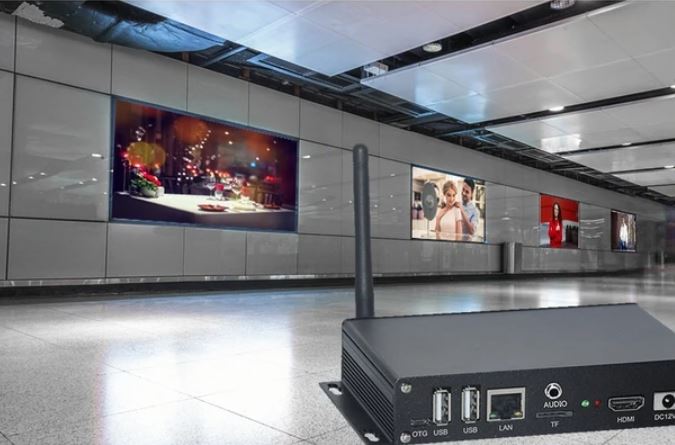In today’s digital age, brand visibility is a critical aspect of a successful marketing strategy. Companies are constantly seeking innovative ways to connect with audiences, stand out in crowded markets, and reinforce their brand presence. One such technology transforming the landscape of brand communication is the best digital signage player. These devices enable dynamic visual content delivery, improving customer engagement and enhancing brand recognition in an impactful manner. In this article, we explore the concept of digital signage players, their benefits, and how they can be effectively leveraged to enhance brand visibility.
What is a Digital Signage Player?
A digital signage player is a device that connects to a digital screen to display multimedia content. These players are essential components of a digital signage system, providing a link between your content and your audience. They process and deliver the content to digital displays, enabling a visually engaging experience for viewers. Digital signage players come in various types, ranging from standalone media players to cloud-based solutions, each offering unique features and advantages for different use cases.
Why Use Digital Signage Players for Brand Visibility?
1. Versatile Content Delivery
Digital signage players allow for versatile content delivery, making it possible to display various types of media such as images, videos, animations, and even live feeds. This versatility helps brands create a dynamic and engaging experience for their target audience. Unlike traditional static advertising, digital signage can be easily updated, enabling marketers to deliver fresh and relevant content. By using digital signage players, businesses can maintain the interest of viewers, which is crucial for enhancing brand recall and visibility.
2. High Audience Engagement
Incorporating visual storytelling is an effective way to connect with audiences on an emotional level. Digital signage players allow brands to craft compelling narratives that captivate viewers and leave lasting impressions. Through the use of vivid visuals, audio, and motion, brands can create an immersive experience that encourages customer interaction and engagement. Higher engagement directly translates to improved brand visibility, as customers are more likely to remember brands that provide engaging and memorable experiences.
3. Real-Time Updates and Customization
Another key advantage of digital signage players is their ability to facilitate real-time updates. Brands can easily update their content to match changing trends, seasonal events, or promotional offers, keeping their messaging relevant to the audience. This flexibility helps in maintaining consistent visibility and ensuring that the brand’s message remains fresh and effective. Furthermore, the ability to customize content for different locations or audiences allows brands to better target their messaging, leading to enhanced visibility.
4. Cost-Effective Marketing Solution
Compared to traditional advertising methods, such as print media or billboards, digital signage players are a cost-effective solution for brands looking to maximize their visibility. Once the digital signage system is set up, the cost of content production and delivery is significantly lower, as there are no printing or distribution expenses involved. Additionally, the ability to update content remotely reduces operational costs, enabling businesses to allocate their marketing budgets more efficiently.
Types of Digital Signage Players
1. Standalone Digital Signage Players
Standalone digital signage players are designed to operate independently without an internet connection. These players are ideal for locations where network connectivity is limited or unreliable. They store content locally, ensuring that it can be displayed without interruptions. Standalone players are cost-effective and easy to set up, making them a popular choice for small businesses and retail environments.
2. Cloud-Based Digital Signage Players
Cloud-based digital signage players are internet-connected devices that store and manage content on the cloud. This type of player offers numerous benefits, such as remote content management, scalability, and the ability to deploy content across multiple screens simultaneously. Cloud-based players are ideal for businesses looking to manage large networks of displays or those that require frequent content updates. With the cloud-based approach, brands can deliver targeted messages and real-time updates seamlessly, improving their ability to stay visible and relevant.
3. System-on-Chip (SoC) Players
System-on-Chip (SoC) players are integrated into the display itself, eliminating the need for an external media player. SoC players offer a compact and space-saving solution for businesses looking to simplify their digital signage setup. By incorporating the player directly into the display, brands can benefit from reduced installation costs and minimal maintenance. SoC players are an excellent choice for businesses that want a streamlined solution without sacrificing functionality.
Best Practices for Using Digital Signage Players to Enhance Brand Visibility
1. Create Engaging Visual Content
Content is the backbone of any successful digital signage campaign. To maximize the effectiveness of digital signage players, brands must focus on creating engaging and visually appealing content. High-quality images, eye-catching videos, and concise messaging are essential for capturing the audience’s attention. Brands should also consider incorporating animations and interactive elements to increase engagement and encourage viewers to interact with the content.
2. Leverage Audience Insights
To make the most of digital signage players, it is important to understand the target audience and tailor content accordingly. Brands should use audience insights to determine what type of content resonates most with their viewers. By analyzing audience behavior and preferences, brands can deliver personalized messages that appeal to specific demographics, increasing the likelihood of capturing their attention and enhancing brand visibility.
3. Utilize Scheduling and Automation
Digital signage players offer scheduling and automation capabilities that allow brands to display different content at specific times of the day. This feature is particularly useful for businesses that serve diverse audiences throughout the day. For example, a restaurant may use digital signage to promote breakfast specials in the morning and dinner offers in the evening. By scheduling content based on audience behavior, brands can ensure that their messaging remains relevant and effective, increasing overall visibility.
4. Choose the Right Placement
The effectiveness of digital signage players is largely influenced by the placement of the displays. Brands should carefully consider where to position their screens to maximize visibility. High-traffic areas such as shopping malls, airports, and busy intersections are ideal locations for digital signage, as they provide maximum exposure to a large number of potential customers. Proper placement ensures that the brand’s message reaches the intended audience and increases the chances of a positive brand recall.
5. Integrate Social Media
Social media integration can significantly enhance the impact of digital signage players. By incorporating live social media feeds or encouraging customers to share their experiences on social platforms, brands can create a sense of community and foster audience interaction. Displaying user-generated content on digital screens not only increases brand visibility but also builds trust and credibility among potential customers.
Industry Applications of Digital Signage Players
1. Retail
In the retail sector, digital signage players are used to promote products, highlight discounts, and provide information on new arrivals. By using digital signage to create an engaging in-store experience, retailers can drive sales and enhance brand visibility. Additionally, digital signage players can be used to display customer testimonials and user reviews, further boosting brand credibility.
2. Hospitality
In the hospitality industry, digital signage players are used to welcome guests, provide directions, and promote on-site amenities. Hotels and resorts use digital signage to display event schedules, restaurant menus, and promotional offers, creating an interactive and informative experience for guests. This not only enhances the guest experience but also helps in reinforcing brand identity and improving overall brand visibility.
3. Corporate Communications
Digital signage players are also widely used in corporate environments for internal communication. Companies use digital signage to display announcements, highlight employee achievements, and share important updates. This fosters a positive work culture, keeps employees informed, and enhances the company’s brand visibility both internally and externally.
The Future of Digital Signage Players
As technology continues to advance, digital signage players are expected to become more sophisticated and feature-rich. Innovations such as artificial intelligence (AI) and machine learning are set to revolutionize digital signage, enabling brands to deliver even more personalized and targeted content. Interactive displays, augmented reality (AR), and data-driven content will further enhance the ability of digital signage players to capture attention and boost brand visibility.
With the growing importance of omnichannel marketing, digital signage players will play a key role in connecting the physical and digital worlds, providing brands with a cohesive way to communicate with their audience. By leveraging the power of digital signage, brands can remain competitive, enhance their visibility, and create a memorable experience for their customers.



